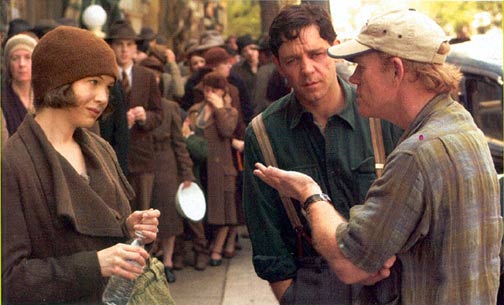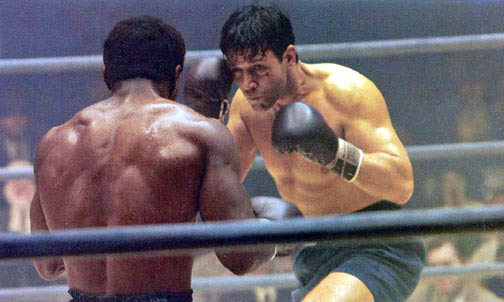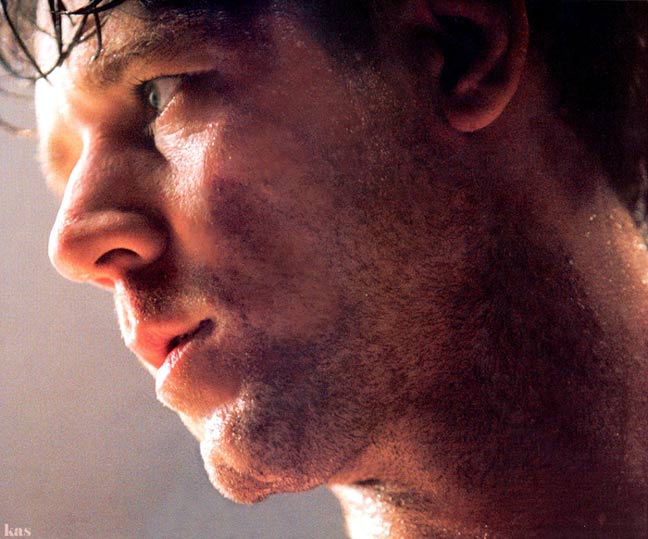Thanks
to Cindy:
Two
Heavyweights. One Great Story.
Cinderella Man, The Legend of a Comeback Boxer - Russell Crowe and Ron
Howard
By Tom Roston, Premiere June 1005
It must have been a real downer walking into the production offices
of director Ron Howard and Producer Brian Grazer during the shooting
of Cinderella Man. On the walls, you would seen black-and-white photographs
of the hollowed-out, woebegone faces of the Great Depression, along
with five television monitors on continuous loops, showing films (such
as Brother, Can you Spare a Dime, Ironweed, The Grapes of Wrath, and
Angels with Dirty Faces) depicting America at its lowest low during
the 1930s. The pictures weren’t all grim, though. There were hopeful
images of resilient children with mismatched shoes playing in the street.
And there was also the archival footage of the boxers of that era (some
of which had been sent over by Martin Scorsese), of fighters like Max
Baer, Joe Louis and Art Lasky, images of brutality, but also of grace,
of struggle and of men who could get knocked down, but who could also
get back to their feet.
And more than any other one boxer, there were reels of James Braddock,
the Irish-American fighter from New Jersey dubbed “Cinderella
Man” because of his dramatic rise from being a down-and-out-former
contender working on the docks to becoming the heavyweight champion
of the world in 1935 by beating Baer, the ten-to-one favorite. Braddock
was a father of three who went on government relief, but who got a second
chance in the ring and miraculously won a string of fights that made
him a hero to a hobbled America. Howard, 51, first heard of Braddock’s
legendary tale from his dad, who grew up in a farming family in Oklahoma
during those hard times. “My grandfather loaded him into the car
and drove him the eight or ten miles to a pool hall to listen to the
Braddock versus Baer fight,” Howard says. “And I remember
my dad telling me the story of this guy who had the championship won
after fourteen impossible rounds, if he could just stay away from Baer.
But he kept going at him. And everyone was afraid he’d get knocked
out. But he just didn’t want to dance around. He wanted to box
to the end. Braddock captivated the nation.”
It was a story Howard had forgotten until one day, when he was working
on 2001’s A Beautiful Mind, and his lead actor, Russell Crowe,
approached him with a script about Braddock and the suggestion that
they make it their next collaboration. Despite the story’s resonance
for him, Howard wasn’t sure he wanted to direct it. “Honestly,
I wasn’t that interested in making a sports movie,” he says.
For Crowe, who had been hoping to get the Braddock project off the ground
for several years already, the fighter’s life story, he says,
gave him “goose bumps. The idea that this life, this change of
fortune had actually happened…I read about Braddock, how he loved
his wife till the day he died. Such a simple story, such simple goodness
and humor. I wanted a man like this to be honored. I wanted his legacy
to be relevant to Americans today. I also felt it important that Americans
be reminded that their abundance has been built on the shoulders of
people like Jim and (his wife) Mae – hardworking parents who put
their children as their first priority.” Finally, after seven
months – “I will admit to being a little tense during that
time,” Crowe says – and with the prospect of Renee Zellweger
in the role of Mae (and, eventually with Paul Giamatti playing the manager,
and Craig Bierko as Baer), Howard agreed. “The human drama of
the time has always interested me,” he says, “Braddock is
a great, classic underdog story; that’s important. But there’s
also this possibility of looking at what it takes for a family to survive.”
Howard, who made his name as a director in the 80s with comedies (Night
Shift, Splash), and is now known better for a category of film that
could be dubbed “highbrow-feel-good” (An oxymoron? Not in
Howard’s hands. See: Apollo 13, A Beautiful Mind), is always looking
to do something different. “When I was a kid, between the three
shows (The Andy Griffith Show, The Smith Family, and Happy Days), I
was basically on a television series for twenty years. And we  were
always doing the same episode over and over again,” he says, adding,
“Time is precious. I wish I could tell more stories.” were
always doing the same episode over and over again,” he says, adding,
“Time is precious. I wish I could tell more stories.”
Although Braddock’s tale sounds like one a Hollywood producer
dreamed up, his life was actually a challenge to dramatize. “Him
Braddock was not a very interesting guy. He wasn’t quirky, and
he didn’t have strong personality traits,” says Brian Grazer.
“He was kind of like Will Rogers. Just a really solid, working-class
American man during the time of the Depression, who happened to be a
boxer.”
Grazer says that Howard, his partner and friend, is especially equipped
to depict such a man: “The thing that makes Ron so unique as a
director is that he seems to find gigantic emotional moments in tiny
little human interactions. He was able to find these tiny little moments
within this ordinary man’s character and turn them into big, tear-jerking
sequences” (Of course, Howard did get plenty of help from meticulously
studying Braddock’s life, allowing him to include in the film
such real-life moments as his response to a reporter’s question
about why he was making his miraculous comeback: “Because now
I know what I am fighting for,” he says, “Milk.”)
The biggest challenge of telling Braddock’s life story was “the
simplicity of the narrative,” Howard says. “That was the
thing that scared me. And that doesn’t sound like much of a risk,
except as a filmmaker who’s trying to advance, to take on a story
which doesn’t have vicious twists and turns and opportunities
for cinematic cool (a reference, perhaps, to A Beautiful Mind)…you’re
counting on pure execution.” The other daunting task was depicted
the boxing (the one place where, Howard adds, he could indulge in such
cinematic cool): ”It wasn’t necessarily apparent to me that
we could achieve that level of detail, and visual impression of what
is was like to be in the ring.”
However, what Howard couldn’t have prepared for was catastrophic
injury: Crowe, who was training in Australia, dislocated his left shoulder
when he hyperextended on a hook that missed its target, just weeks before
shooting was to begin. Faced with surgery and a rigorous training regimen
with unpredictable results, and a major overhaul to the production schedule,
the entire film was in doubt. Howard says that Universal head Stacey
Snider talked with him about trying to use a stunt double for some of
Crowe’s boxing scenes. “And I said, ‘Stacey, it’s
a boxing film. He’s out there in shorts; we can’t double
him at all.’ And Russell, the first thing he said was, ‘Don’t
let them talk you into trying to double me, Ron. I will get this injury
squared away.’”
The surgery was a success, and six weeks later, Crowe was back in the
ring training. But that didn’t mean Cinderella Man was in the
clear. Once shooting began in April of 2004 in Toronto (a location picked
partly because its Maple Leaf Gardens was the best replica of New York
City’s 1930s Madison Square Garden), Howard was haunted by fears
of Crowe reinjuring himself. “It made the whole shoot tense,”
he recalls, “Every time I had to ask him to do another take, I
was on pins and needles. And it kept hurting and it kept flaring up.”
The boxing scenes, most of which were going to be shot over a set period,
were cut from four days a week to three and then, finally, to two, with
everyone keeping an eye on Crowe’s shoulder. “If he got
injured again, then you’re really screwed, because you might not
ever finish the movie,” Grazer says.
But Crowe seemed unfazed. “It was unbelievable,” Paul Giamatti
says. “The shoot actually seemed to go smoothly, considering the
fact that he had screwed his shoulder up. He’s a remarkably focused
guy.”
“They would have to call me in as per the shoulder: ‘Bring
in shoulder relief!’” says Zellweger. “I was shoulder
relief.” The actress relished the chance to work with fellow Oscar-winners
Howard and Crowe. “Clearly, they are a great team. It’s
a fun place to be in the middle of all these ideas being thrown around
and being invited to participate.”
On first glance, the pairing of the actor known for being irascible
(as Crowe described himself to costar Giamatti) with the director known
as one of the nicest guys in Hollywood (Howard hedges: “I don’t
know how nice I am. I think I’m a reasonable guy”) seems
odd. But they can quickly identify their common link. “We like
to do a day’s work,” says Crowe. “I think that is
our main common ground.” Howard agrees. “We have this real
interest in working our asses off to tell a story.”
“For Russell, everything is trust. And Russell does seem to trust
Ron quite a bit,” says Grazer, who then alludes to how Crowe’s
work ethic may have led him to lock horns with Craig Bierko, his onscreen
adversary. “Those two guys had a real tough time with each other.
I think it was an actor thing because they were so involved in their
roles that they became those people. Russell is not only very, very,
very talented, but also very intense. And Craig stayed in the ring with
the guy, which was great. Russell was always testing that and probably
was doing it as an actor, ‘cause he wanted to guy to be tough.”
In fact, Bierko’s performance is indeed fierce, and it happens
to be the most notable of the 40-year-old actor’s career.
Working with Crowe may not be like dealing with, say, a Tom Hanks (who
starred in Splash and Apollo 13), but it’s something that Howard,
who may sign on for a third project (The Power of Duff) with the New
Zealand-born actor, savors. “Neither guy suffers fools. One guy
might be a little more polite about it, but there will still be a conversation,”
Howard says of his two muses.
Of Crowe, Howard adds, “He’s intense; his moods change.
A lot of it has to do with where he is in the scene and how he’s
feeling about the work that’s being done. Working with Russell
is a little like filming on an amazing tropical island. You’re
there because you want the place, you want everything it offers. But
the weather’s going to change several times in the same day. And
you may want to take advantage of the weather or you may have to wait
it out. But it’s part of why you are there.”
“I’ve acted with all types, I’ve directed all types,”
Howard says. “What you want to understand as a director is what
actors have to offer. They’ll get at it however they get at it.
If you can understand that, you can get your work done.”
As a director, Howard says that what he has to offer the audience is
an understanding of what it was like. “That’s the phrase
I use a lot – what’s that like? What was it like in the
capsule? What’s it like in the fires of Backdraft? What’s
it like to be a schizophrenic?” he says. “Here, there were
two of those: What’s it like to be in the ring? And the other
is, What's it like to have the rug pulled out from under you?”
That latter question was something Howard first asked more than 30 years
ago, when he was better known as Ronny Howard (or, to TV viewers, Opie),
a high school kid making his first film ‘that wasn’t a lark,”
a 30-minute documentary about the Great Depression for which he interviewed
elderly people who had lived through the era. “I really lost myself
in making that,” Howard says. In fact, he dug that film up and
added some of the vintage photos he used in it to the collection on
his office walls, hoping they would inspire his cast and crew to better
imagine just what the difficult era was like.
Images
thanks to Kaspi at Kaspinet
|

